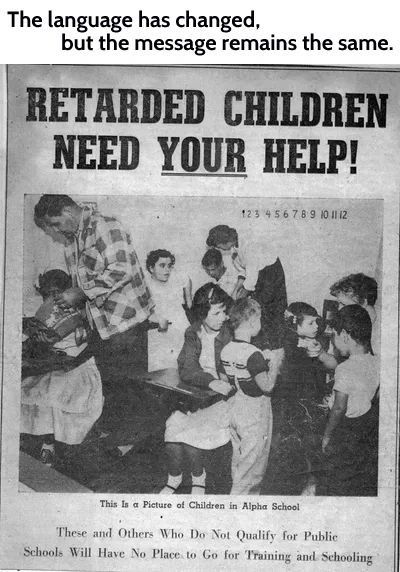The History of Alpha
Three mothers dreamed of a better way
While 1953 is the year Alpha Resource Center was born . . .
It was the fall of 1950 when the dream was conceived. As Edna Dahl, one of the founding mothers noted,
"Our Council had its origin in the minds and hearts of the parents of three young retarded children (Candace Anderson, Elaine Roberts and Norman Dahl) in the fall of 1950. Desiring some educational opportunity for their children, they hired college students majoring in speech to teach the children. Classes were held in a small building at the home of one of the parents - two hours a day, three days a week, These sessions were continued on a private basis until February 1953, when the Santa Barbara City Schools established a class under the then-designated Point 2 program - a State-legislated permissive, not mandatory, training program for the trainable mentally retarded."
From there what was birthed began to grow and expand at a rate no one expected. Classes continued to grow and community support made new venues possible. Then, as Edna describes again in her own words, the future became a reality,
"In September 1955 our hopes were realized, when the City Schools took over the complete program, providing teachers, facilities, equipment and transportation for the Point 2 classes at Garfield School."
No longer were Candace, Elaine, and Norman on the outside looking in. Now, just as it continues today, they were part of the school system, showing the world they had a capacity to learn and contribute in ways once not thought possible.
By 1956, public support was starting to expand and in 1957 recreational programs began. Soon "bazaars, operated food booths and information booths at civic affairs, etc. - anything to raise a few dollars and to inform the public of our work" became the precursor to the Alpha Resource Center and Thrift Stores of today.

Through the years, Alpha has built upon this foundation . . .
While progress was being made, not all children with intellectual and developmental disabilities qualified for the Point 2 classes. In 1956, a very determined grandmother, Vera Howie, with her own resources hired a teacher and opened a new school in a small room at the Presbyterian Church in Summerland. Mrs. Howie chose the name “Alpha” because it meant “beginning” and reflected her commitment to all children, like her granddaughter Colleen, who deserved not only an education, but social and recreational opportunities as well. In 1957, by unanimous vote of the membership, the Santa Barbara Council took over the operation of “Alpha School” and began their search for a piece of property on which to build a permanent school.
In April 1966, Alpha's current home on Cathedral Oaks Road was dedicated. Over the years services were expanded, allowing Alpha to support individuals from birth to end of life. Alpha has evolved from a primarily campus/classroom-driven organization to one that is out in the community, allowing individuals to experience life on their terms, supported as they develop the fullness of their potential.
We have come a long way since 1953, but the road ahead is still long. Alpha will pursue its mission to empower individuals with intellectual and developmental disabilities, support families, and build a community where the contributions of all people are valued.
Ventures like Slingshot Art Studio and Gallery showcase the ability of Alpha's artists. And SlingShot is just a glimpse of the future. Additional community-based, interest specific programs are in the early stages.
As Alpha continues to grow, it will shape the landscape for the entire Santa Barbara community, from Carpinteria to Goleta and into the north county, highlighting the amazing abilities of people with intellectual and developmental abilities that those three mothers recognized and helped blossom in their own children. Little did they know how broad their reach would be and how many individuals and families would be blessed by their hard work and determination.

A glimpse into the past
Joan and Susie budget planning - 1970s
01/21
Visit the rest of the Alpha family - SlingshotArt.org | AlphaThriftStore.com | AlphaLifespan.org
2018 © Alpha Resource Center of Santa Barbara


